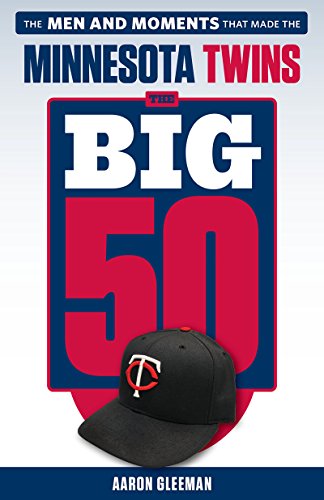January 24, 2005
First Impressions
I was doing some research for a future project on draft picks when it struck me just how impressive the Twins' 2004 draftees were in their professional debuts. Though Minnesota had to wait until the 20th pick in the draft to make their initial selection, they had a total of five of the draft's first 39 picks thanks to losing free agents Eddie Guardado and Latroy Hawkins during the offseason. Their first pick was high school shortstop Trevor Plouffe (who hit .283/.340/.380 in 60 games in rookie ball), but then they loaded up on pitching. After Plouffe, the team's next six picks were spent on pitchers and they used a total of 14 of their first 17 selections on pitchers.
The team's run on pitching started with the #22 pick and University of Minnesota lefty Glen Perkins, who went 19-5 with a 2.88 ERA in two years with the Gophers. Perkins signed quickly for $1.425 million and reported to Elizabethton of the Appalachian (Rookie) League, where he had a 2.25 ERA and 22 strikeouts in 12 innings. The team then promoted him to Single-A Quad Cities, where Perkins had a 1.30 ERA and 49 strikeouts in 48 innings. Overall, he posted a 1.50 ERA and 71-to-16 strikeout-to-walk ratio in 60 pro innings, while climbing up two steps on the organizational ladder. That's about as good as a debut gets.
The 25th overall pick was spent on Kyle Waldrop, a high school righty from Tennessee. Waldrop signed for a million bucks and reported to the Gulf Coast (Rookie) League, which is one level below Elizabethton. He dominated there for seven starts, posting a 1.42 ERA in 38 innings, and then moved up to Elizabethton. Waldrop continued to impress there, with a 3.24 ERA and 25 strikeouts in 25 innings. Any time a high school pitcher puts up a 2.14 ERA and 55-to-7 strikeout-to-walk ratio in his first taste of pro ball, it's extremely impressive.
Minnesota's next pick (#35) was used on Matt Fox, a right-handed pitcher who went 14-2 with a 1.85 ERA in his final year at the University of Central Florida. Fox signed for $950,000 and reported to Elizabethton, where he pitched fairly well despite a 5.40 ERA. In 27 innings, he struck out 32 batters, walked eight, and held opponents to a .264 batting average. His biggest problem was allowing six homers in 102 at-bats.
The team's final first-rounder (#39) and fourth pitcher selected was Jay Rainville, a high school righty from Rhode Island who went a jaw-dropping 6-0 with a 0.00 ERA and 70-to-3 strikeout-to-walk ratio in 42 innings during his senior year. Rainville signed for $875,000 and joined Waldrop in the GCL, where he had a 1.83 ERA and amazing 38-to-3 strikeout-to-walk ratio in 34 innings.
Minnesota's four "first-round" pitchers combined for 184 innings pitched and a 2.35 ERA in their pro debuts. Perhaps even more impressive is the fact that they all had outstanding strikeout-to-walk ratios in their first taste of pro ball, combining for 196 strikeouts (9.6 K/9 IP) with just 34 walks, or 5.76 strikeouts per walk. To put that in some context, Curt Schilling led the American League with 5.80 strikeouts per walk last season and Brad Radke finished third in the league with 5.50 K/BB.
The strong pitching debuts from the 2004 draft class stretched beyond the first-rounders, too. Anthony Swarzak, the #61 overall pick out of a Florida high school, tossed 48 innings with a 2.62 ERA and 42-to-6 strikeout-to-walk ratio in the GCL. Eduardo Morlan, the #91 pick also out of a Florida high school, had a 2.84 ERA and 28-to-10 strikeout-to-walk ratio in 25 GCL innings. The #151 pick, Nevada high school lefty Jeff Schoenbachler, had a 3.92 ERA and 45-to-16 strikeout-to-walk ratio in 39 GCL innings.
The team's eighth-round pick out of the University of Arkansas, Jay Sawatski, had a debut similar to Perkins', throwing 34 innings with a 1.59 ERA and 38-to-12 strikeout-to-walk ratio between Elizabethton and Quad Cities. Even guys who had mediocre ERAs like John Williams (#211) and J.P. Martinez (#271) managed excellent strikeout rates and outstanding strikeout-to-walk ratios.
Here are the numbers of the 12 pitchers drafted and signed with the team's first 17 overall selections:
PITCHER IP ERA SO BB SO/9 K/BB
Glen Perkins 60 1.49 71 16 10.6 4.4
Kyle Waldrop 63 2.14 55 7 7.9 7.9
Matt Fox 27 5.40 32 8 10.8 4.0
Jay Rainville 34 1.83 38 3 10.0 12.7
Anthony Swarzak 48 2.62 42 6 7.9 7.0
Eduardo Morlan 25 2.84 28 10 10.0 2.8
Jeff Schoenbachler 39 3.92 45 16 10.4 2.8
Patrick Bryant 32 4.26 21 13 6.0 1.6
John Williams 38 5.40 50 14 11.7 3.6
Jay Sawatski 34 1.59 38 12 10.1 3.2
J.P. Martinez 43 3.80 49 19 10.3 2.6
Kyle Aselton 38 4.54 38 19 9.0 2.0
The Twins made a conscious effort to stockpile pitching in the 2004 draft, taking an interesting mix of raw high school arms and polished college pitchers. So far at least, it has worked out phenomenally well, as the team signed each of the first 12 pitchers they selected in time for them to make their pro debuts, and then watched as they collectively had an excellent first season (with a combined 3.55 K/BB). If things go similarly well this season, Minnesota will have a steady flow of young pitching coming up through the system, led by Perkins, who could be ready for a big-league gig as soon as 2006.
Today at The Hardball Times:
- Top 50 Prospects: Year in Review (41-50) (by Aaron Gleeman)
- Paying for the Best (by Studes)

